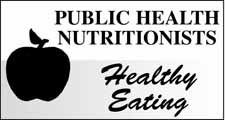Studying how consumers shop has become a science. "Market researchers have worked for years to come up with ways to make sure shoppers see as many products as possible, because the more they see, the more they buy," says Marion Nestle, New York University professor of Nutrition, Food Studies, and Public Health.
Making healthy choices can be difficult, especially when shoppers are overwhelmed by the large selection of products, savvy sales tactics and the variety of nutrition messages in the media. Making these choices can be easier, when you know how to conquer the grocery store!
Make A ListStart by planning ahead and making a list of things you need. You may find it useful to sort your list into sections of the grocery store. Grocery shopping can be made even easier if you plan your meals for the week. This will ensure that you have everything you need. There will be no emergency trips to the store for missing ingredients. Finally, never go hungry. If you shop on an empty stomach there is a better chance that you will make unhealthy choices that are not on your list.
Plan Your RouteGrocery stores are designed to make you buy more. Marion Nestle gives a perfect example of why you have to walk so far to get certain foods, "Milk is always as far from the entrance as possible, so you'll walk past thousands of tempting products. Just about everyone buys at least two impulse items for every item on a shopping list". Planning your route may make it easier to avoid the impulse items that make it into our grocery cart. Plan to stay on the outside perimeter of the store.
This is where you will find the four food groups. For the most part the inner isles consist of convenience type foods. By planning a route and sticking to it you will notice it is easier to focus on getting only the healthy items on your list.
Trust Your CartUse your cart as your guide. The largest basket should mostly consist of fruit and vegetables and grain products. The smaller folding basket should be used for milk products and foods from the meat and alternatives group. Finally, the bottom portion of your cart should be where you place other foods such as oils, fats and foods high in sugar.
Use The LabelLook for cereal, bread and grains that have at least 2 g of fibre per serving.Choose low fat processed meats, crackers and prepared foods. Try to choose items that have 3 g or less fat per serving.
When buying cheese choose a product with 20% M.F. or less and for yogurt choose one with 1% M.F. or less.
Processed meats and canned soups, sauces and vegetables are commonly high in sodium (salt). If the Daily Value for sodium is 10% or less, it means that there is little sodium. A Daily Value of 25 % or more means the food has a lot of sodium.
Check out the ingredient list - the list starts with the ingredient used most in the product. By developing a plan and using labels, grocery shopping can be easy. So, what are you waiting for? Grab a pen and paper, it's time to develop your menu, make your list and plan your route!Written by the Public Health Nutritionists of Saskatchewan and supported by Public Health, Sunrise Health Region.
If you have any comments or questions please contact: Heather Torrie, Public Health Nutritionist, Sunrise Health Region, 150 Independent Street, Yorkton, Sask. S3N 0S7 or phone: 786-0600.




